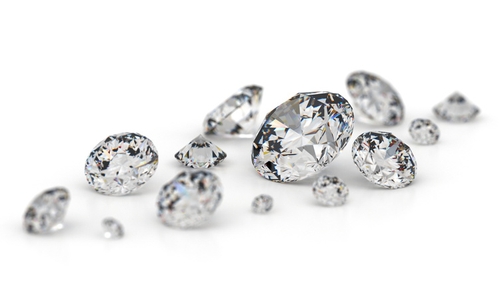4 C's of Diamonds
What are the 4 C's of Diamonds?

Simply put, the 4 C's are Cut, Clarity, Carat, and Color. The color of the stone ranges from D-Z of the alphabet with D being the best. Cuts are also known as the shape, whether it be princess cut or another. Clarity is the amount of imperfections under 10 power magnification, also refered to as the "fingerprint" of the stone. Carat is the weight of a diamond. But there is so much more to learn about your diamond!
DGJ's Diamond Education
Key to the Diamond Quality Pyramid
Examine each of the 4Cs -- cut, clarity, carat weight and color. The combination of the 4Cs determines the value of a particular diamond. For example, a colorless diamond is at the top of the Diamond Quality Pyramid in color...but if it lacks clarity, is small, or not well cut, it will be of a lower value. The finest stones possess the rarest quality in each of the 4Cs, and are the most valuable. Strive for a stone that offers the best combination of the 4Cs. Knowing a diamond's combination will help you to make an informed decision. Ultimately, you'll discover the unique combination of the 4Cs that makes a particular diamond the right choice for you. Its beauty and brilliance will capture the true sentiment of the occasion.

CUT
The Better Cut a Diamond, the More Brilliant
A well cut or faceted diamond, regardless of its shape, scintillates with fire and light -- offering the greatest brilliance and value. While nature determines a diamond's clarity, carat weight and color, the hand of a master craftsman is necessary to release its fire, sparkle and beauty. When a diamond is cut to good proportions, light will reflect from one mirror-like facet to another and disperse through the top of the stone, resulting in a display of brilliance and fire. Diamonds that are cut too deep or too shallow lose light that spills through the side or bottom. As a result, poorly cut stones will be less brilliant and beautiful -- and certainly less valuable -- than well cut diamonds higher on the Diamond Quality Pyramid.

CLARITY
The Purer a Diamond, the More Brilliant
The greater a diamond's clarity, the more brilliant, valuable and rare it is. Virtually all natural diamonds contain identifying characteristics, yet many are invisible to the naked eye. Under the scrutiny of a jeweler's 10x-magnifying loupe or microscope, natural phenomena -- called inclusions -- may be seen. These are nature's birthmarks, and they may look like tiny crystals, clouds, or feathers. Diamonds categorized as internally flawless reveal no such inclusions, inside the diamond. Flawless stones are at the peak of the GIA grading system, and are treasured for their rarity and beauty. Diamonds with very, very small inclusions are graded as VVS1 or VVS2. The larger the inclusion, the lower the grade and the less rare the diamond. Inclusions that can be seen with the naked eye are graded I1 or I3. The number, color, type, size and position of surface and internal birthmarks affect a diamond's value. Major inclusions can interfere with the path of light that travels through a diamond, diminishing its brilliance and sparkle and therefore its value.

CARAT WEIGHT
The Larger a Diamond, the More Rare
Larger diamonds are found relatively infrequently in nature, which places them at the rarest level of the Diamond Quality scheme. What also makes a bigger diamond so desirable is that it shows off a stone's fine color and cut, and therefore its brilliance, to its best advantage. A diamond's size is measured in carat weight, and each carat is equal to 100 points. A .75 carat diamond is the same as a 75-point diamond or a 3/4 carat stone. While larger diamonds are highly prized, diamonds of equal size may vary widely in value and brilliance, depending on their qualities of clarity, cut, and color.

COLOR
The More Pure the Color in a Diamond, the More Rare
Diamonds are graded by color, starting at D and continuing through the alphabet. Truly colorless stones, graded D, are treasured for their rarity and value, is the highest it can be graded. While many diamonds appear colorless, they may actually have subtle yellow or brown tones and these color grades include P and Q. Although still beautiful, they will be less rare and therefore less valuable. "Fancy" diamonds -- in well-defined colors that include red, pink, blue, green and canary yellow -- are highly prized and particularly rare.
HOW DISTINCTIVE GOLD JEWELRY CAN HELP
The Fifth C: Confidence
We like to establish long standing relationships with customers, and we take pride in finding quality diamonds for them. We love to service a loyal customer who continues their confidence in us from generation to generation. We are experts, knowledgeable and accessible, and we are able to explain the 4Cs, as well as show you a selection of diamonds in a range of prices. While all diamonds are beautiful, only by comparing stones will you be able to appreciate what makes one more rare and valuable than another. Keep in mind that there are no "bargain" diamonds; there are only diamonds of different value, weight and brilliance. Choose a diamond shape that suits your personal taste. The classic Round Brilliant, Oval, Pear, Marquise, Princess, Heart and Emerald shapes are among the most beautiful and popular today.
WHAT TO SPEND
Diamond Buyer's Guide
When you start to think about buying a diamond -- and the love it will symbolize -- you naturally want the best you can afford and a beautiful stone you will treasure forever. Diamonds can be found in a range of prices -- and you're certain to find one within your budget that suits your taste and what you plan to spend. If you're about to buy a Diamond Engagement Ring, you may want to consider spending the commonly accepted guideline of two month's salary. But it's up to you to settle on a diamond that will truly represent your deepest emotions and the promise for the future you will share. How can you be sure to choose the perfect diamond for her? She may already have dropped hints by admiring a photograph or someone else's diamond. Browse with her at a trusted jeweler. Share your knowledge of the 4Cs. Later, surprise her with a diamond beyond all her expectations. When it comes to other types of diamond jewelry, such as a Diamond Solitaire Necklace and Diamond Solitaire Stud Earrings, purchase the diamond that captures the brilliance of the moment. Choosing a quality diamond to celebrate life's most intimate occasions is a truly rewarding experience for the one who gives as well as for the one who receives.
The new revolution in diamonds is the "lab grown" or lab created" diamond. These are nearly the same as a natural diamond we are all used to the only difference is they were not formed by the Earth, but by man. While the same C's apply to them, they typically cost less and are more sustainable.
WHEN YOU FIND THE RIGHT DIAMOND
An Occasion Worth Celebrating
Now that you understand why some diamonds are rarer than others, you can make an informed decision. Choose a beautiful stone that combines the qualities of the 4Cs you most value. Then you're ready to give the most enduring gift of love. Born of the earth, reborn on the woman you love, this diamond is more than a precious gem and all that it symbolizes...it's a piece of forever.





